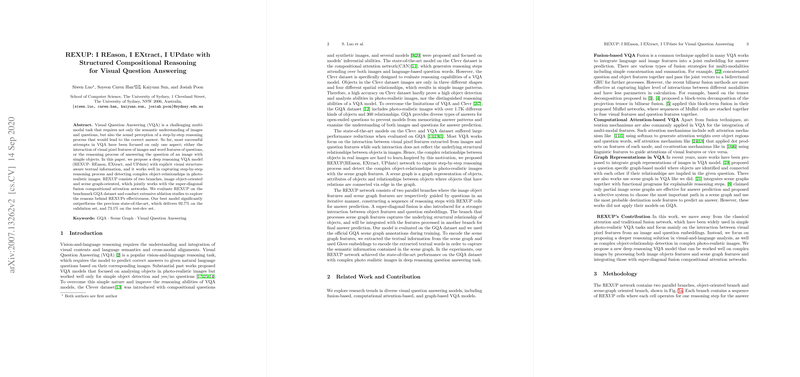Evaluation of REXUP: A Structured Approach to Visual Question Answering
The paper under discussion introduces REXUP, a novel architecture designed to tackle the intricacies of Visual Question Answering (VQA) by integrating compositional reasoning with complex visual relationships. The REXUP model ('I Reason, I Extract, I Update') supersedes many traditional VQA paradigms by integrating explicit structural relationships from scene graphs with conventional image features, allowing for a more robust and semantically rich analysis capability.
Conceptual Framework and Technical Approach
REXUP consists of two principal components: the image object-oriented branch and the scene graph-oriented branch, which together enable the system to capture and utilize complex inter-object relationships in images. A super-diagonal fusion network facilitates a deeper interaction between visual and textual information by creating a multi-dimensional projection that reduces computational costs while maintaining a high level of interaction between modalities.
The methodology follows an iterative approach, with each iteration (or REXUP cell) comprising three gates: Reason, Extract, and Update. The Reason gate focuses on identifying relevant question components, whereas the Extract gate targets significant objects from the knowledge base, informed by scene context and previous iterations. The Update gate consolidates information, revising the system’s understanding step-by-step.
Empirical Validation and Impact
The REXUP model was tested against the GQA dataset, a comprehensive resource for evaluating VQA systems with its rich variety of objects and relationships. The model achieved a notable accuracy of 92.7% on the validation set and 73.1% on the test-dev set, significantly outperforming previous models such as LXMERT and MAC networks. These results indicate that integrating scene graph features and a structured reasoning approach can significantly enhance a VQA model's capability to process complex questions.
Moreover, the authors provide a thorough ablation paper to dissect the contribution of different network components. The computational gains particularly underscore the efficacy of the parallel structure between object- and scene-graph oriented branches, as each significantly boosts the model's understanding by capturing different aspects of the image.
Future Directions and Implications
The most salient contribution of REXUP is its structural approach to reasoning in VQA tasks, which opens up several promising avenues for future research. Extensions of this work could include applying similar architecture to related tasks such as visual reasoning or multi-modal sentiment analysis, where complex understanding of context and object relationships is crucial.
Additionally, future work might investigate the real-time application of REXUP in environments such as autonomous robotics or assistive technologies, where the ability to interpret visual scenes accurately and respond contextually to natural language queries holds enormous practical value. As visual datasets evolve and are expanded, REXUP’s structured reasoning could serve as a foundational framework for developing more generalizable and adaptable AI systems.
The REXUP paper significantly enhances the understanding of how scene graph-based interactions and structured reasoning can improve VQA systems, potentially influencing a wide array of applications where cognitive reasoning with visual information is crucial. This work stands as a cornerstone for further exploration of compositional reasoning and structural model design within AI research.
